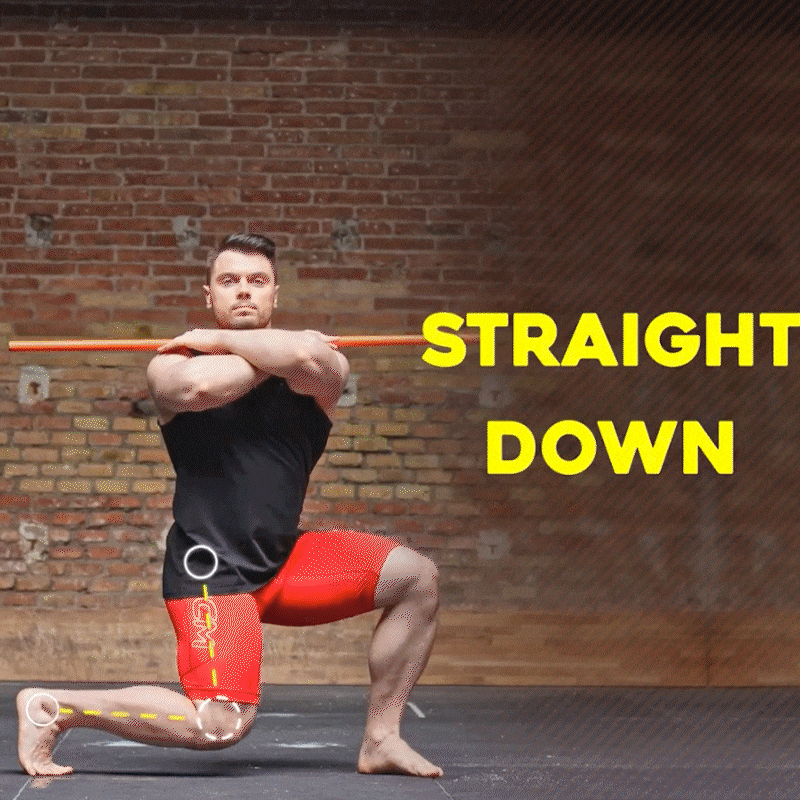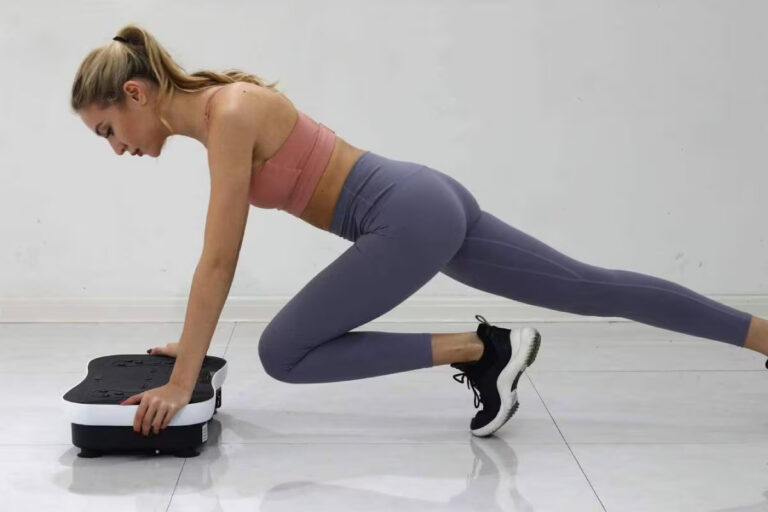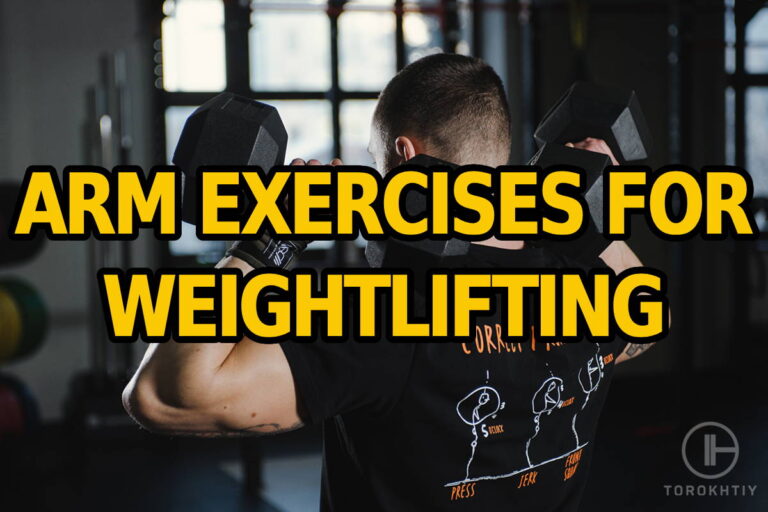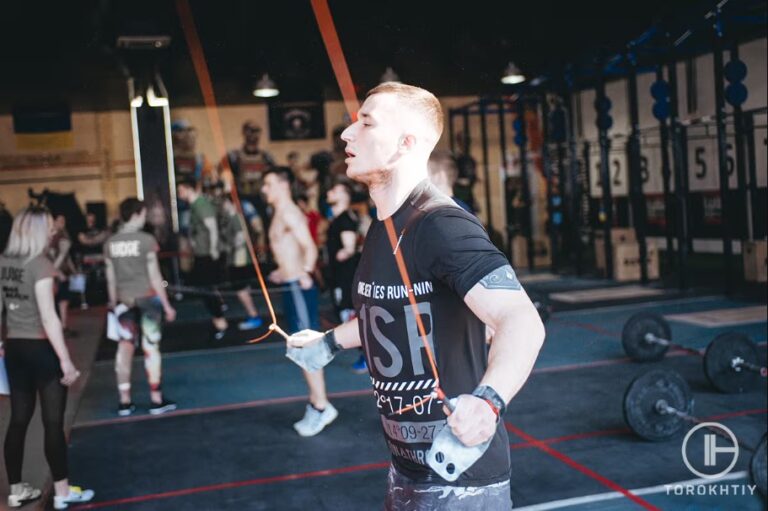Mobility Routine for Lifters
Reviewed by: Oleksiy Torokhtiy (21 years of Oly Lifting experience)
Do you ever feel stiff when you’re lifting weights? Are you struggling to hit your entire range of motion on deadlifts?
In that case, you can add a mobility regimen to your training sessions. Poor mobility can lead to decreased performance and increased injuries, which is why weight trainers need to focus on mobility.
What is a Mobility Routine for Lifters? A mobility routine for lifters is a series of exercises designed to improve your range of motion and reduce stiffness in areas used during lifts, such as hip mobility, shoulders, and spine.
From shoulder mobility to ankle mobility, various exercises can help you move, feel, and lift better.
These exercises focus on stretching tight muscles and increasing flexibility to move more quickly.
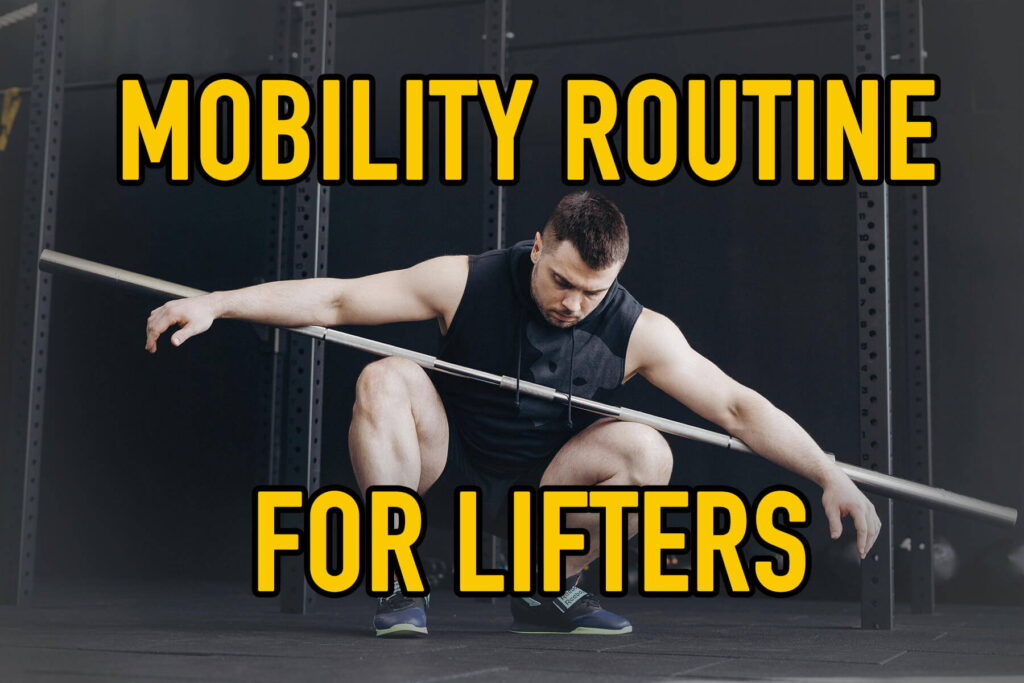
Mobility Routine for Lifters
Mobility refers to your body’s ability to move freely and without restrictions. The combination of flexibility, strength, balance, and coordination allows you to perform movements easily.
Mobility training is a form of exercise focused on improving the range of motion in joints and muscles and overall muscle and tendon elasticity.
A good mobility routine for lifters should include exercises that target areas such as the hips, shoulders, ankles, and wrists.
Additionally, exercises focusing on core stability are essential for weightlifters and powerlifters alike. Implementing a dedicated mobility routine into your workout regimen can help you reach new heights in your lifting journey!
🔻Full-Body Mobility Program
Mobility For Weightlifting is a 12-week training program for Olympic Weightlifting and other sports, designed for a total body mobility and flexibility development.
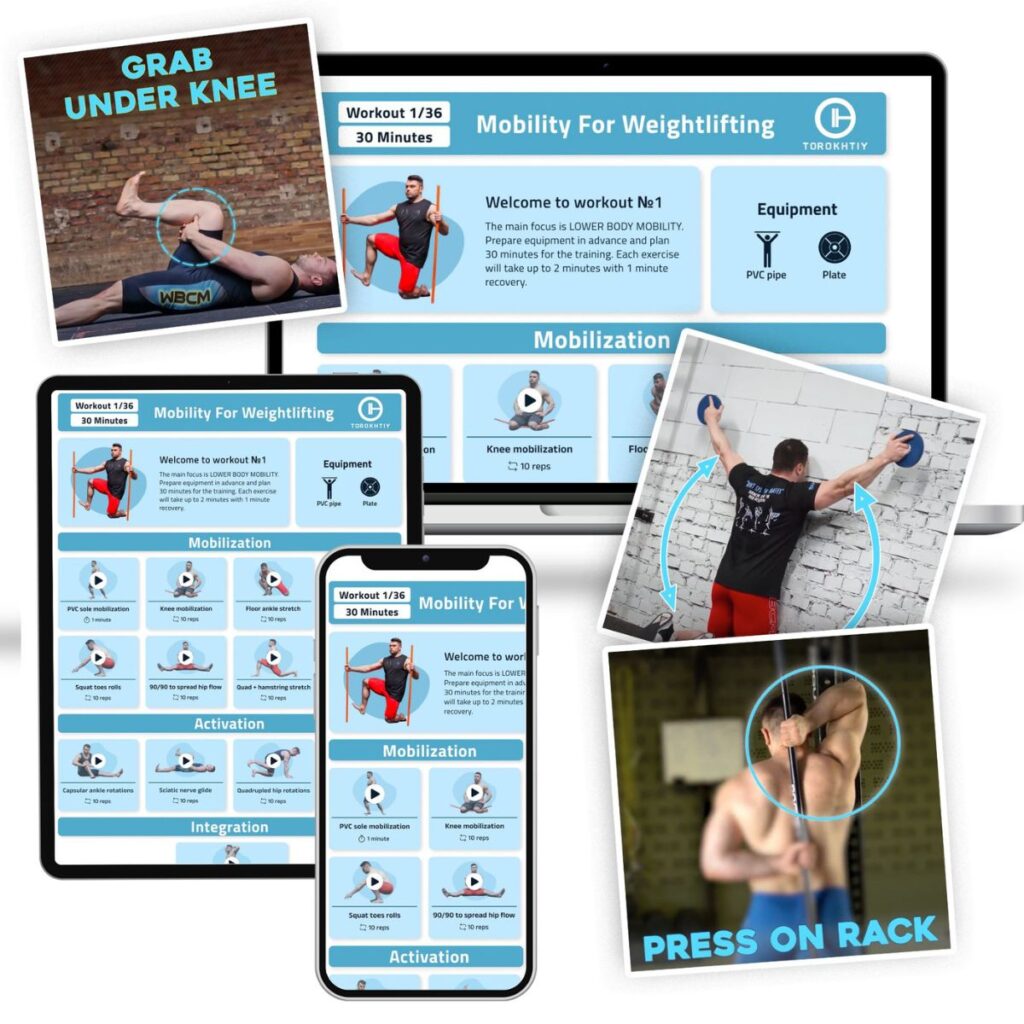
Good For:
1️⃣ Athletes of All Sports and Levels:
Increase your mobility and reach new PRs in lifting — whether you’re into Olympic lifting, Powerlifting, or Functional Fitness.
2️⃣ Those Who are Dealing with Pain:
Pain or other discomfort could be triggered by lack of joint mobility.
3️⃣ Coaches:
Learn new and help your athletes become better.
The Difference Between Mobility And Flexibility
There is a difference between these two names despite their frequent synonymy. Flexibility is just one piece of the mobility puzzle.
Flexibility refers to the range of motion available in a joint. It is the ability to move a joint through its full range of motion without pain or restriction.
Mobility, on the other hand, is more comprehensive and includes flexibility but also involves strength, coordination, and balance.
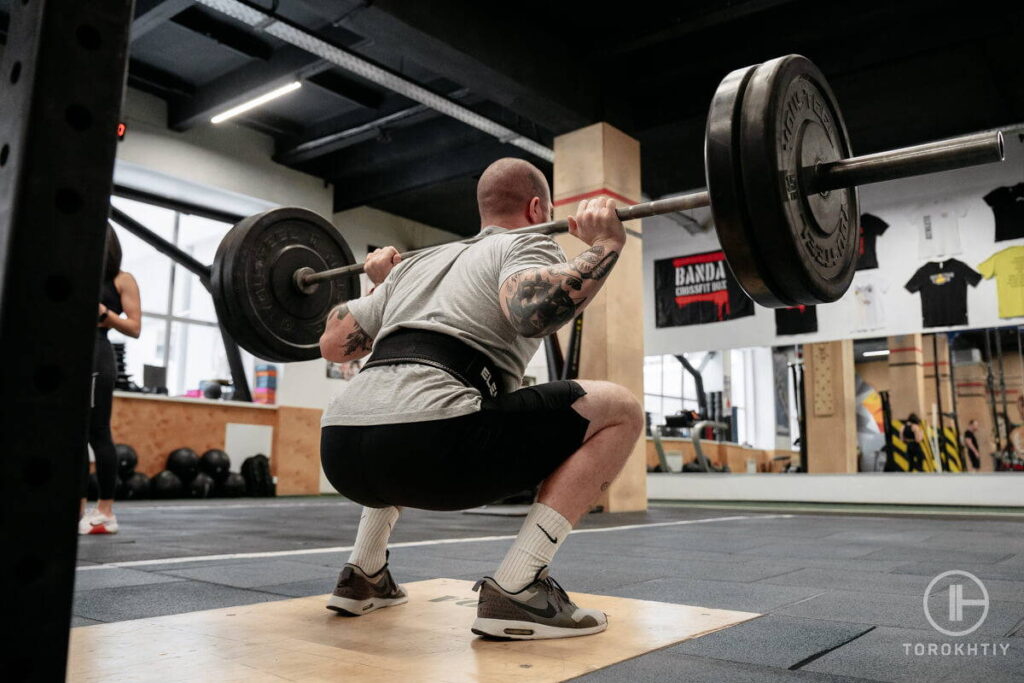
Top 3 Reasons for Lifters to Make Stretching a Part of Their Workouts
One of the most prevalent ways to stretch is through static poses. It involves holding a position without movement, usually lasting 30–60 seconds. Stretching is often done in stationary positions. You’ll need to stay perfectly still for anywhere from 30 seconds to a minute.
Static stretching helps improve flexibility and reduce muscle tension, which can benefit athletes preparing for sports activities or anyone who wishes to stay in shape.
Dynamic stretching, on the other hand, does involve movement throughout the stretches and is often used by individuals for general warm-ups. It can help activate muscles, increase the range of motion, and prepare the body for more intense exercise such as running or playing sports.
Dynamic stretching requires constant repetitions, which can also become more physically challenging as you improve your range of motion and strength.
With dynamic stretching, it’s essential to take caution; if performed too aggressively, it could risk injury due to overstretching muscles or ligaments beyond their natural state.
See below for the top 3 reasons to include stretching in your workouts:
Increased Flexibility
Before you do any weightlifting mobility exercises, ensure you warm up properly. This will increase flexibility and help reduce the risk of injury during your lifting session. A good mobility routine can improve flexibility, range of motion, and coordination, which allows for better form when doing lifts.
For example, hamstring stretches can help you reach a lower depth when squatting, while shoulder stretches can help you lock your arms in an overhead position.
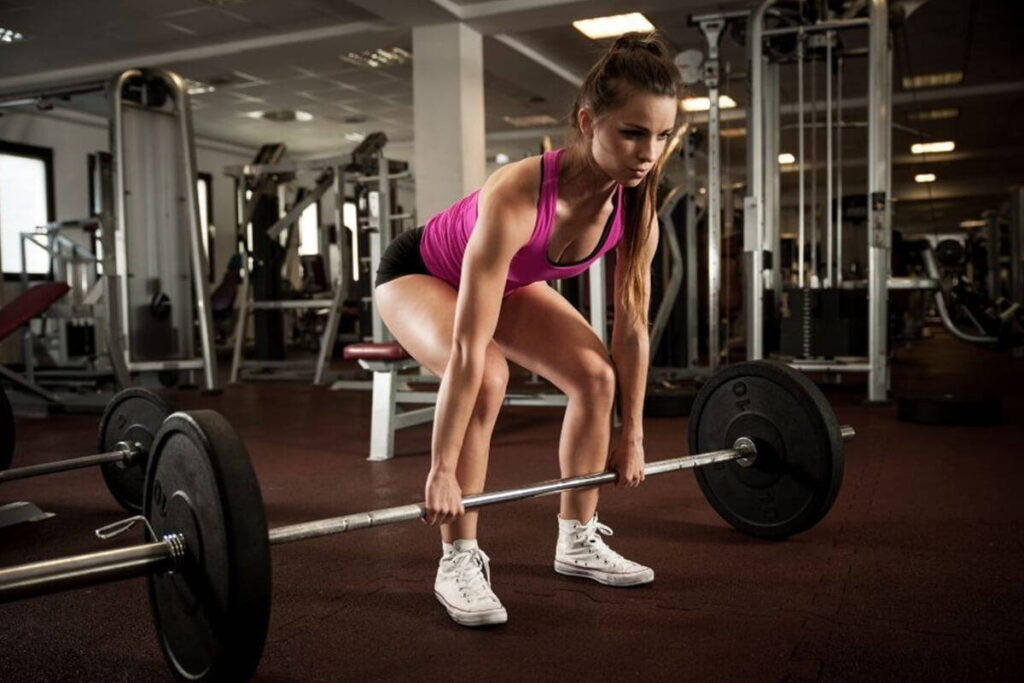
Injury Prevention Exercise
Every weightlifter has a phase where they often neglect stretching before workouts. One day, they felt a sudden sharp pain in his lower back and had to stop immediately, leading to an injury that could have been avoided if they had done a proper mobility routine beforehand.
Improved Performance
Finally, proper flexibility, strength, and balance are essential to perform movements easily. A good mobility routine can also help improve performance by allowing you to use the correct form and technique during workouts.
Remember to include mobility exercises for weightlifting that target areas such as the hips, shoulders, ankles, and wrists into your mobility routine to get the best results.
Essential Mobility Exercises for Weightlifting for Peak Performance
Mobility exercises are essential for lifters to maximize their performance in the weight room.
By increasing flexibility, range of motion, and core strength, you’ll be able to lift heavier weights with greater ease and reduce your risk of injury. Here are three mobility exercises for lifters to incorporate into their routine:
Foam Rolling
Foam rolling is an essential part of any lifter’s regimen. It helps reduce muscle tension, increase circulation in those areas, and promote better recovery times. Foam rolling can also activate the muscles needed for a particular exercise and improve coordination between them. Use your foam roller after your workout to promote better recovery.
Squat Therapy
Squat therapy is dynamic stretching that combines a full range of motion for the hips and ankles with a resistive motion. It helps improve flexibility in those areas, essential for any weightlifter looking to get into a proper position during squats and deadlifts. Example of a starting position: Stand with your feet hip-width apart and your hands clasped together.
Squat down until your thighs are parallel to the ground, then push through your heels to return to the starting position. Repeat for 8–12 reps.
Wall Slides
To get the most out of foam rolling, it should be done before and after lifting—about 10 minutes each time. Start by targeting larger muscle groups, such as your quads, hamstrings, glutes, and back. Apply moderate pressure with slow and controlled movements over each area for 30–60 seconds while focusing on your breath.
90/90 Stretch
The 90/90 stretch is a great mobility exercise to improve the flexibility of your hip joints. This stretch also helps improve hip and leg muscles’ coordination and balance.
Starting from a seated position with your left leg bent at a 90-degree angle in front of you, perform the squat. Your shin bone must be perpendicular to the floor while your knee is extended upwards.
Next, bring your right foot out toward a 45-degree angle, resting it so that it is slightly behind your right thigh. Make sure to keep both hips level throughout this exercise.
Deep Squat With Single-Arm Overhead Reach
The deep squat with a single-arm overhead reach is a functional exercise that improves squat mobility and thoracic spine extension.
This full-body exercise targets multiple muscle groups to help improve force production, balance, and coordination, making it an excellent choice for increasing overall athleticism.
This dynamic move starts by standing with your feet almost shoulder-width apart. It would be best if you squatted down until your thighs parallel the floor and your knees reach the sides of your arms.
The key is maintaining a flat stance on the ground, an upright torso, and straight arms.
Once in a full squat position, raise one arm overhead with your thumb pointing back, reaching as far as possible without losing proper form.
Focus on maintaining proper posture with your core engaged during the entire exercise sequence. This is the one mobility routine for lifters to help you reach peak performance in the weight room.
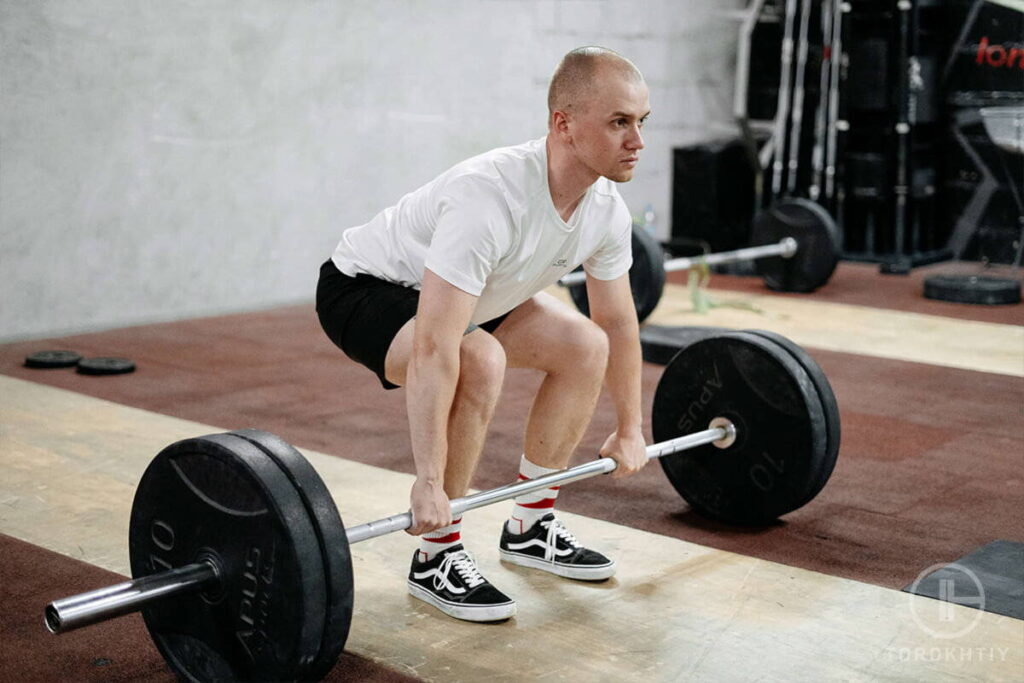
Quick Note: Avoid This Stretching In Your Powerlifting Mobility Routine
New research suggests that it is best to avoid holding stretches for too long before lifting weights, especially if strength is the goal.
According to a systematic review by Kay and Blazevich (2012), static stretching lasting longer than 60 seconds may result in significant strength loss. The researchers pooled together data from 106 individual studies, and this is what they found:
- Static stretching of less than 30 seconds resulted in a -1.1% to +1.8% decrease in strength.
- Stretching for 30-45 minutes caused -1.9% to 3.4%.
- Stretching for 1-2 minutes caused -4.2–5%
These findings support the idea of dynamic stretching instead of static stretches before exercise.
Dynamic stretches actively engage the muscle and its corresponding tendon while rapidly stretching; this increases flexibility while decreasing muscle mass loss due to overstretching, which can contribute to weakened physical performance overall.
Bodybuilders must adhere to these guidelines when selecting their powerlifting mobility routine to maximize gains!
🔻Test Your Mobility Before Starting the Program
Mobility is crucial because it directly impacts your performance, technique, and overall safety.
Complete 3 simple tests to evaluate your current mobility.
Our Program Includes:
- 📺 80 Videos for every exercise:
Unique movements, supported by detailed graphics and voice-over. - 📆 36 Workouts x 30 minutes each:
12-weeks plan can be used as standalone program or as a pre-/post-workout training. - 📊 Tests to track you progress:
Make simple tests in the beginning and after finish to elevate your result. - 🏋️♂️ Made by Olympian:
Designed by a Champion, under the guidance of PhD in sport science and physiotherapist. - 💲One-time payment:
No monthly or any other recurring payments. One payment, life-time usage.
FAQ
Does Mobility Help Lifting?
Yes! Mobility exercises help to increase flexibility and range of motion, which are key components for improving your performance in the weight room.
Should You Do Mobility Before Or After Lifting?
It is best to perform mobility exercises before lifting, as they help warm and prepare the body for the upcoming workout.
Conclusion
In conclusion, combining your lifting practice with a mobility exercise will greatly benefit your performance and health. Take the time to stretch, foam roll, and move your body in ways that support your lifting goals. Your body will thank you for it and feel stronger and more capable. Keep lifting and keep moving!
We want to hear from you! Share your experience with mobility exercises for weightlifting in the comments below, and let us know if you have any questions or tips.
Also read:
- Overhead Squat
- Upper Body Mobility Exercises
- Overhead Squat Assessment
- Tricep Stretches
- Squat Stretches
- Neck Mobility Exercises
- Trapezius Stretches
References:
- So You Want to Be More Flexible? Here’s How to Get Started // Healthline: https://www.healthline.com/ health/fitness-exercise/ how-to-be-more-flexible
- The importance of stretching // Harvard: https://www.health.harvard.edu /staying-healthy/the-importance-of-stretching
- Effect of Acute Static Stretch on Maximal Muscle Performance: A Systematic Review // Researchgate: https://www.researchgate.net/ publication/51207368_Effect_of_Acute_ Static_Stretch_on_Maximal_ Muscle_Performance_A_ Systematic_Review
Why Trust Us?
With over 20 years in Olympic Weightlifting, our team does its best to provide the audience with ultimate support and meet the needs and requirements of advanced athletes and professional lifters, as well as people who strive to open new opportunities and develop their physical capabilities with us.
By trusting the recommendations of our certified experts in coaching, nutrition, dietology, and sports training programming, as well as scientific consultants, and physiotherapists, we provide you with thorough, well-considered, and scientifically proven content. All the information given in the articles concerning workout programming, separate exercises, and athletic performance, in general, is based on verified data. We ensure that you can rely on our professionals’ pieces of advice and recommendations that can be treated as personalized ones which will benefit you and fully meet your needs.
The product testing process is described in more detail here
Author: Sergii Putsov
Head of Sport Science, PhD
Best Results: Snatch – 165 kg,
C&J – 200 kg
Sergii Putsov, Ph.D., is a former professional weightlifter and National team member, achieving multiple medals in the 94 kg weight category at national competitions. With a Master’s degree in “Olympic & Professional Sport Training” and a Sport Science Ph.D. from the International Olympic Academy, Greece, Sergii now leads as the Head of Sport Science. He specializes in designing training programs, writing insightful blog articles, providing live commentary at international weightlifting events, and conducting educational seminars worldwide alongside Olympic weightlifting expert Oleksiy Torokhtiy.
Reviewed by: Oleksiy Torokhtiy
Olympic Weightlifting Champion
Best Results: Snatch – 200 kg,
C&J – 240 kg
Oleksiy Torokhtiy is a professional athlete boasting 20 years of experience in Olympic weightlifting. With multiple European and World titles under his belt, he has showcased his prowess in two Olympic Games (Beijing 2008 and London 2012). Upon concluding his illustrious career, Oleksiy dedicated himself to coaching. By 2022, he had conducted over 200 weightlifting seminars worldwide. He is the visionary behind an international sportswear and accessories brand known for its motto, “Warm Body Cold Mind.” Additionally, he is an esteemed author and the creator of a series of training programs and eBooks.

